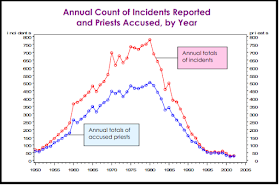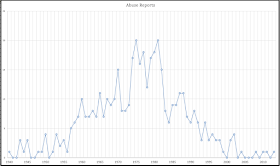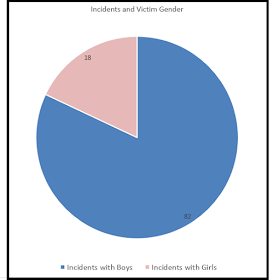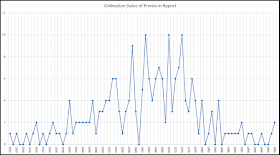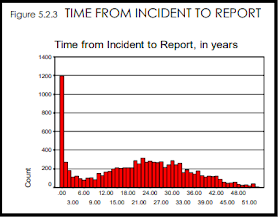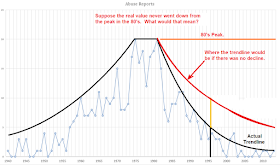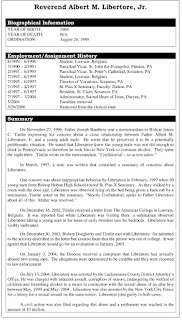From the Mailbag:
In mid-August (2018) the attorney general of Pennsylvania released their grand jury report on sexual abuse in the Catholic Church. The full text can be found [here].
It’s been the subject of much discussion and reporting, and it seems like every Catholic blogger on the planet has an opinion about it. What led to the abuse? Who is to blame? What do we do about it?
I’m interested in those questions, of course. They are critical to the safety of our kids and the well-being of the Church in America. But I don’t think I have anything useful to add to the matter.
So today I’ll do what I’m good at… crunching data. I’ve now gone through 800 pages of abuse reports — (a challenging task on multiple levels) — and kept some stats along the way.
Is there anything we can learn from the data itself?
Let’s find out.
1: The Same Iceberg
Back in 2002, the United States Conference of Catholic Bishops commissioned an independent study of the sexual abuse history of the Church in America. The result was the John Jay Report, the full text of which can be found [here].
It gave us a snapshot of the pedophilia / ephebophilia crisis which looked like this:
It showed an increase starting around 1955, a peak between 1975 and 1980, which then fell to pre-1955 levels in 1995. That was the scope of the abuse crisis back in 2002.
Now, when the Pennsylvania Report came out, it led to headlines which implied the abuse crisis was continuing unabated, as if there had never been any decrease in incidents.
Is that supported by the findings of the Pennsylvania Report? No.
As I said above, I went through the entirety of Section 5 of the report and documented every year in which a report was made. Here is the resulting histogram:
The trends of the histograms match. This means the Pennsylvania Report doesn’t reveal a *new* crisis. Instead it describes how that crisis was felt in Pennsylvania.
Both datasets show that 1960-1990 (a full generation!!!) was a terrible time to be a Catholic child. And the period from 1970-1985 was worst of all.
If it is any comfort, we can see that the levels of abuse have now fallen.
2: Most of the Incidents Involved Boys
This has been observed elsewhere, but the victims were predominantly male. As I was tracking the incidents of reported abuse, I found 18% involved a female victim. The remainder were boys.
3: It is Still Just the Tip of the Iceberg
Another thing which became obvious when reading the reports was that there are many, many more unreported cases. Tons.
Let me give you a typical example:
- A priest was ordained in 1979.
- A complaint is made about the priest in 1984.
- The diocese pays money to the family of the victim
- The priest is sent away for “evaluation.”
- The evaluation determines the priest is just fine — (they always did).
- Another complaint is made in 1992.
So now we have two registered complaints against the priest. But do you really think he only began abusing kids in 1984? Do you think he didn’t abuse any kids between ’84 and ’92? The idea is ludicrous.
The behaviors recorded in the report makes clear that these men were incurable, compulsive addicts. A few sessions of counseling wasn’t going to cure them.
On a personal note: I remember meeting a fella at a friend’s wedding who became immediately angry and hostile when I mentioned I was Catholic. He said he was a former Catholic himself. At the time I figured he’d fallen victim to bad anti-Catholic preaching. Reading the Penn. Report has made me reflect if there wasn’t more behind instant hostility.
He would have been a Catholic kid in the 1960’s.
4: Something was Desperately wrong in Seminaries from 1950-1985
The Pennsylvania Report recorded the ordination dates for most of the offending priests. As one might expect, it showed an increase in sexually perverted men being ordained for a whole generation. The peak of this chart occurs from 1960-1975, ten years preceding the peak of the abuse reports.
What was happening in those seminaries? What was happening in American culture? Why the rise in defective men?
5: The Decline is Real
Now a person might say:
“How do you know there has been a decline in cases? Perhaps things are as bad as ever, but the victims haven’t come forward yet.”
Well… that possibility is worth looking at. After all, it’s true that victims often delay in reporting until long after the events in question.
This is where the John Jay report has some light to shed. It catalogues how long victims take to report their abuse. Here is the chart:
If you were to rearrange the graph in terms of percentage of cases reported over years, it would look like this:
When the data is arranged this way, we can see that 50% of the cases are reported by the 22nd year.
Now let’s take a look back at the abuse data.
Suppose the abuse never subsided from the 1980s peak. Using the report % data from the John Jay report, we can estimate what the reported abuse trendline would be if there was no real decline.
The current year is 2018. Compensating for unfiled reports, if there was no real decline since the 80’s, we’d see the level of reported cases from 1995 (23 years ago) rising to half of the 80’s peak. (Because that’s long enough for half the reports to come in.) But instead, the data shows the reportage level at about a quarter of the 80’s peak.
This means there is a decline even when one compensates for delayed reporting.
That said, I believe the delayed reporting effect is likely less pronounced today. A person who reported abuse prior to 2002 was doing so alone. Today the idea of abuse from Catholic clergy has entered into the public consciousness and I suspect this makes it less difficult to come forward.
6: Better Policies Matter
As I mentioned before, the cases in Section 5 of the report followed a pattern:
- A priest would take advantage of the implicit trust which parents place in him.
- Priest would abuse minor.
- A complaint would be filed against the priest.
- He’d go for counseling for evaluation.
- The counseling center would say he’s fine.
- The parents would take a cash settlement.
- The priest would be reassigned
- Repeat.
One could go on all day about the abject failure of the bishops in protecting their flock. It seemed they wanted to treat the abuse as a personal matter, to be worked out “in the Church.” And their first priority was to protect the reputation of their diocese. Only when parents had the good sense to go to law enforcement were results achieved.
[And here I have to note something which I’ve not seen other people say. The negligence of the parents in many of these cases is staggering. Over and over again, parents would complain to the bishop, get ignored, and NEVER go to the police. What were they thinking?!]
Anyway, Section 3 of the Pennsylvania Report says conditions began to improve after 2002. Specifically, the report says the following about the modern day:
This bares out in the case files. Here are three examples from the Scranton Diocese which stretch into recent times: (Click to enlarge)
After 2002, the collective eyes of the American media were fixed on the Church. The incurability of pedophiles became well-known and suddenly pastors and bishops weren’t taking chances on abusive clerics.
In the three cases above you can see how Church officials got law enforcement involved and quickly removed the offending priest. This is typical of modern cases which appear in Section V of the Pennsylvania Report.
Conclusion:
When sharing these conclusions with folks, a common response has been:
“What nonsense is this? You’re saying everything is fine and we can relax about our children’s safety now? You are shameless!”
This is a nonsensical response. There’s an ocean of difference between saying “things have improved” and “all is well.” And as the recent Cardinal McCarrick scandal has shown, our Catholic bishops still have a lot to learn.
The improvements we’ve seen since 2002 did not come from any improvement in our bishops’ moral character. It came because of a newspaper exposé, a public outcry, and the strong arm of the government. The implicit trust which parents used to afford to priests is gone. And while it is sad that priests today live under a dark cloud of suspicion, that is the price paid for the horrors of the past.
As a lay person and a father of young boys, I say: Never again.
Improvements still need to be made. Without the constant vigilance of the laity and law enforcement, we have no expectation that they will happen — or even that we won’t slide back into 20th century negligence.
So, one cheer for the improvements the bishops have made. Three cheers for the laity who demand better from them.
[Resources: Steven O’Keefe’s website]
[Return to www.spiritdaily.com]
=
=
=
=
=
=
=
=
=
=
=
=
=
=


